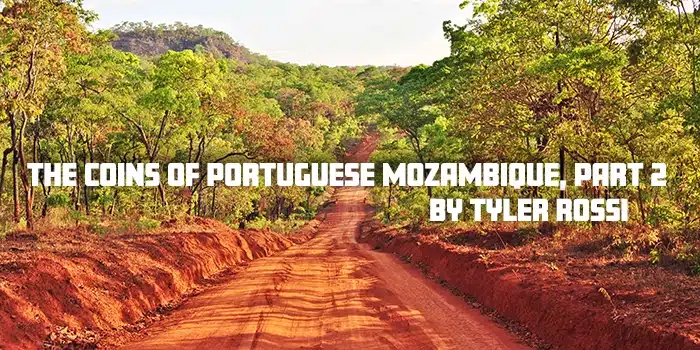
By Tyler Rossi for CoinWeek …..
Part 1 | Part 2
* * *
While Portugal originally claimed a massive swath of Africa–from Angola on the west coast to Mozambique on the east coast–the British Empire disputed the Iberian nation’s right to a number of central territories. A subsequent ultimatum delivered on January 11, 1890, threatened British military action against Portuguese colonial holdings scattered across the globe. King Carlos I, forced to comply with British demands, lost the last of his public support. This unrest led to a rise in republican agitation and the eventual assassination of both the king and his chosen heir on February 1, 1908. As a result, when Carlos’ younger son Manuel came to the throne, he was only 18 years old.
In the national elections of 1910, the monarchy again came under direct threat, and it was only a few months later on October 3, 1910, that an armed republican mob overthrew the king and declared a republic.
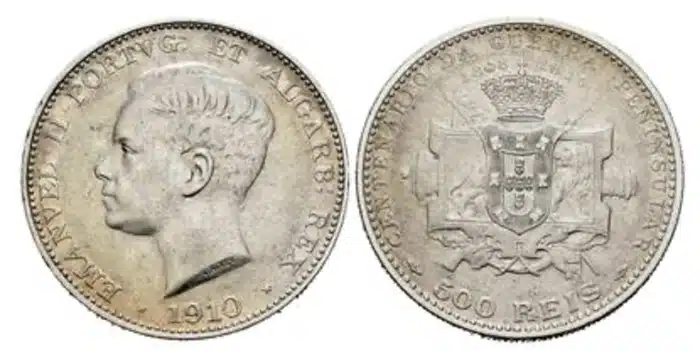
Phase Three: Private-Issue Coinage
During this period, Portugal did not have the ability to maintain its overseas economies. With few financial resources at their disposal, the royal government in Lisbon did not strike any coins dedicated for use in Mozambique for a significant period. Disregarding the foreign coins counter-stamped under Luis I (r. 1861-1889) and Carlos I (r. 1889-1909), the last royal coins struck for Mozambique were those of Maria II.
Nevertheless, the local economies still required coinage, and to fill this void, the government allowed a number of private companies to lease massive quantities of land. These privately chartered companies were granted near total control of the people and resources on the land they held.
With a handful of charters being distributed during the 1890s, Mozambique quickly became dominated by three large companies: the Mozambique Company, the Niassa Company, and the Zambezia Company.
Of these three, the only company to strike a metal coinage was the Niassa Company. This company, founded in 1891, it was granted a royal charter giving it control of the provinces of Cabo Delgado and Niassa, which totaled a combined area of over 60,000 square miles. Using an initial influx of capital sourced from British and French investors, the company struck a number of tokens denominated in 10 and 20 reis. These pieces served a similar role to those of the British East India Company. Acquired by a German bank in 1914, the company was eventually seized by the British government during World War I. Consequently, the Portuguese government was happy to refuse an extension by the time the company’s charter expired in 1929.
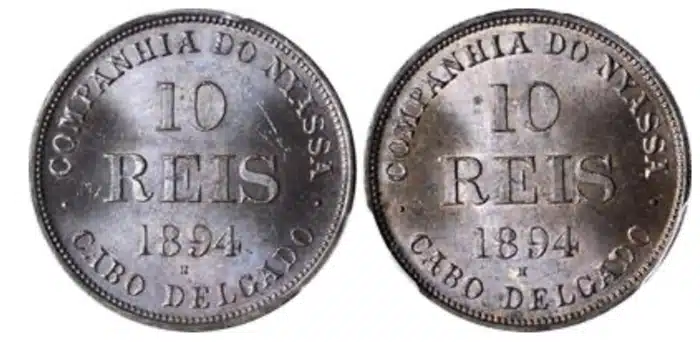
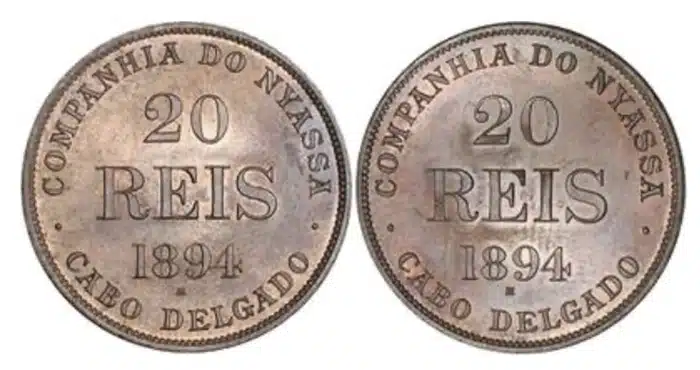
The Mozambique Company, which controlled the provinces of Manica and Sofala in the center of the country, did print a number of banknotes. Most were printed after the Real was discontinued in 1911 and were actually denominated in libras. The company was headquartered in Beria until 1972.
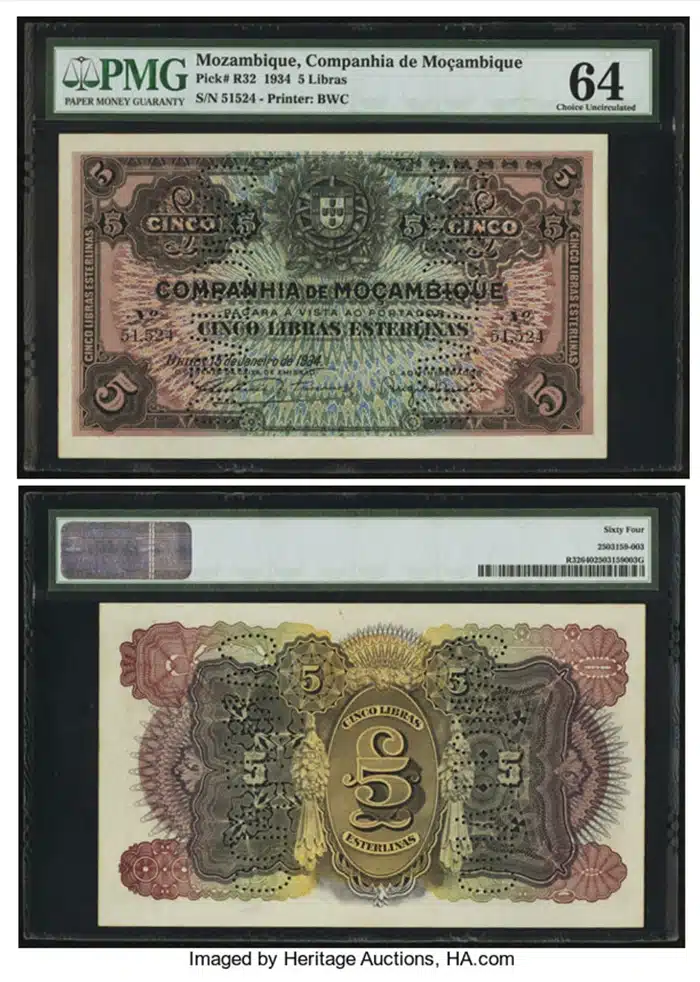
Phase Four: The Escudo
This last phase of colonial coinage in Mozambique began with the introduction of a new unit of account, the Escudo, in 1911. As a decimalized currency, each Escudo was divided into 100 Centavos. When the transition was made, the government set an exchange rate of 1 Escudo per 1,000 old Reis. By 1914, the Escudo banknotes were being printed by the Banco Nacional Ultramarino. These came initially in amounts of 10, 20 and 50 centavos, as well as 100 and 1000 Escudos denominations. Later in 1920, the bank added 1, 2 ½, 5, 10, 20, and 50 Escudo notes.
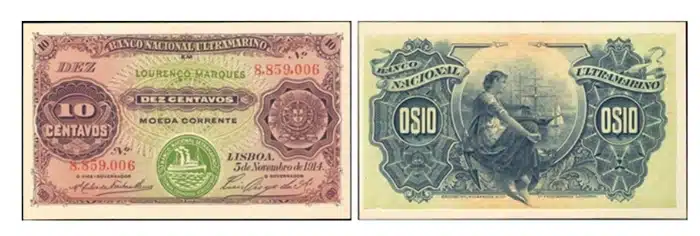
As with most of Europe, the late 19th and early 20th centuries was a time of great change for Portugal, albeit for a slightly different reason. Initially nominally neutral during the First World War, the Republic ultimately sent military expeditionary forces to its African territories to combat the German African colonial forces. Even after successfully participating in the Entente alliance, Portugal only received .75% of the German war indemnity, roughly 990,000,000 German marks. When compared to the vast economic expenses of the war effort, this trifling indemnity proved insufficient and led to a period of dramatic economic and social upheaval in Portugal. Eventually, the weakened republic fell to a military coup in 1926. Quickly taken over by General António de Oliveira Salazar, this dictatorship would remain in power until 1974.
However, due to this domestic political and economic upheaval, the first Mozambique Escudo coins were not struck until 1935. The first mintage in 1935 was comprised of only 1.2 million 2.5 Escudos and 1 million 5 Escudos. These silver coins weighed 3.5 and 7 grams, respectively, and were all struck from .650 pure silver. Both denominations had the same design and are differentiated solely by the obverse denomination and size. The obverse depicts the National Republican Coat of Arms surrounded by the legend COLONIA DE MOÇAMBIQUE and the denomination (2$50 / 5$00) below. The reverse design is centered on the old royal shield superimposed on the Portuguese globe and Maltese cross design. REPUBLICA PORTUGUESA and the date (1935) both ring this device, just inside the coin’s outer rim.
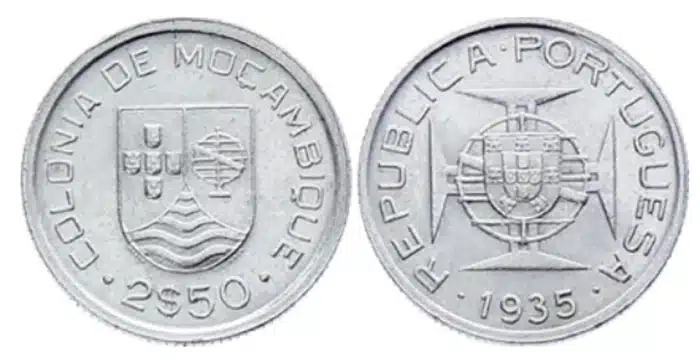
One year later, Lisbon issued five additional denominations: the copper 10 and 20 centavos, the cupronickel 50 centavos and 1 Escudo, and silver 10 Escudos. While the new silver 10 Escudos coin shared the same design as the earlier 1935 2.5 and 5 Escudos, the smaller base metal denominations were slightly different. The obverse shield was changed to the shield of Portuguese Mozambique. While retaining a similar obverse, the reverses did not have the royal shield, globe, and cross motif. Instead, they all displayed the denomination in the central field. Ultimately, these designs would all end up being single-year issues. As early as 1938, the colonial government began issuing coins with an updated obverse design.

This design, which maintained the original legend, featured the same shield superimposed on globe motif. However, the globe now displayed a modern rendition of a mural crown formed of crenelated castle towers. The first denominations updated, in 1938, were the silver 2.5, 5, and 10 Escudos. Three years later, in 1941 the copper 20 centavos was changed, followed by the bronze 10 centavos in 1942. Lastly, in 1945 the Cupronickel 50 Centavos and 1 Escudo were updated. An additional change was made, the new issue of 1 Escudo coins in 1945 was shifted to bronze. After World War II concluded, the 20 centavos was reissued in bronze over two years (1949-1950) and both the 50 Centavos and 1 Escudo Mozambique coins were struck in a nickel-brass alloy in 1950 and 1951.
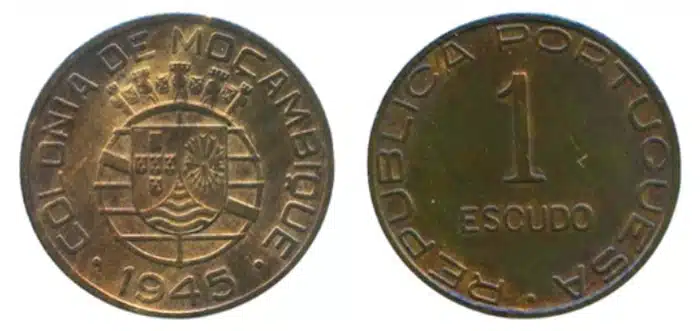
By this time, the Portuguese government was trying to tamp down calls for independence from its various colonies. While unable to commit military resources, unlike other colonial powers, Lisbon was able to grant provincial status. Therefore, on June 11, 1951, a law granting provincial status to all colonies passed the Portuguese parliament. Henceforth, the colony of Mozambique became known as the Overseas Province of Mozambique or Provincia Ultramarina de Mocambique.
While still named and denominated as Escudos, Mozambique coins struck prior to 1951 and the subsequent currency reform of 1953 were technically a colonial currency and not convertible to the domestic Portuguese Escudo at a 1-1 parity. It wasn’t until the next series of coins were released that they became a unified and fully convertible currency. This allowed Lisbon to establish the Escudo Zone in 1962. This free trade monetary union proved to be a complete failure, due mainly to an imbalance in the flow of funds between the new provinces. In 1964, the Escudo zone crashed, and Lisbon once again made the Mozambique Escudo non-convertible to the home currency.
The only major design change made on these new coins was to the obverse legend. Instead of reading COLONIA DE MOÇAMBIQUE, it simply said MOÇAMBIQUE.
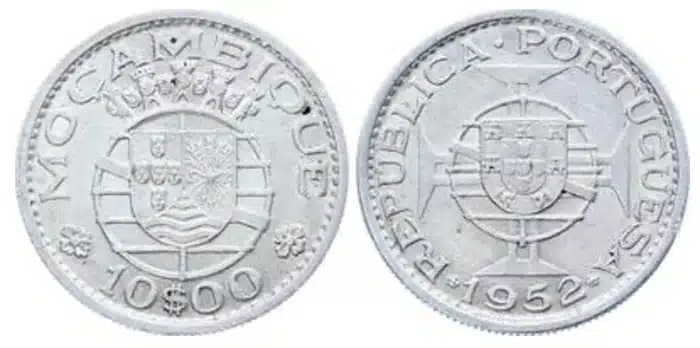
In 1952, the last new denomination was issued. These new silver 20 Escudos coins were struck in .720 fine silver from 1952 until 1960. When struck again for a single year (1966) the fineness was reduced to .680 silver. The last series of 20 Escudo Mozambique coins, produced over two years (1971-2), was struck on nickel planchets. This trend was similar for all of the silver coins. In 1952, the 2.5 Escudo was struck on cupronickel planchets, the 5 Escudos was shifted to cupronickel in 1971, and the 10 Escudos in 1968. Also, all denominations from the 1 Escudo down, were struck from bronze.
Ultimately, after a decade-long war of independence (1964-1974) that resulted in tens of thousands of military and civilian casualties, Mozambique broke away from Portugal. This marked the end of Portuguese control – as well as the Escudo. Coinciding with the cession of fighting, no coins were issued after 1974.
However, as a fledgling independent state with few resources to establish their own mint, the Republic of Mozambique chose to retain the Escudo. The first calls for a new currency came in 1975 with the proposal of the Metica. Five years later, in 1980, the Metical finally replaced the Escudo. The Mozambique government allowed for a three-day exchange period where the old Escudo coins could be exchanged at a 1-1 ratio, starting on June 16.
* * *
Sources
Standard Catalog of World Coins – 1901–2000, 45th Edition. Krause Publications. (2018)
https://www.academia.edu/43303017/Conflict_Potentials_in_Monetary_Unions
https://www.brookings.edu/wp-content/uploads/2016/06/20031017.pdf
https://www.imf.org/external/pubs/ft/wp/2009/wp09146.pdf
https://projects.kora.matrix.msu.edu/files/210-808-9577/al.sff.document.nusa198007.pdf
https://uir.unisa.ac.za/bitstream/handle/10500/21785/dissertation_pateguana_c.pdf?sequence=1
https://projects.kora.matrix.msu.edu/files/210-849-30102/PWACOA12-68Portopt.pdf
* * *
About the Author
Tyler Rossi is currently a graduate student at Brandeis University’s Heller School of Social Policy and Management and studies Sustainable International Development and Conflict Resolution. Before graduating from American University in Washington D.C., he worked for Save the Children creating and running international development projects. Recently, Tyler returned to the US from living abroad in the Republic of North Macedonia, where he served as a Peace Corps volunteer for three years. Tyler is an avid numismatist and for over a decade has cultivated a deep interest in pre-modern and ancient coinage from around the world. He is a member of the American Numismatic Association (ANA).




